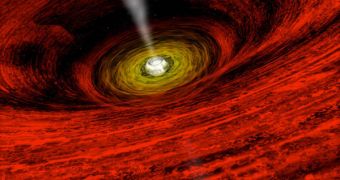Black holes, once highly misunderstood formations, have over the years captured the imagination of astronomers and film producers alike, and have been prominently featured in films and in literature. In spite of the high levels of attention they were given, there are still a great many things that remain unknown about them, and therefore more studies are required. Rather than studying the real deal in space, experts from the Dartmouth College propose a new method of creating artificial ones in the lab, at much smaller scales than their supermassive counterparts.
In a new scientific paper, published in the August 20th issue of the American Physical Society's flagship journal Physical Review Letters, the team explains the basics of constructing a quantum black hole at a very small scale. The new constructs could help them better understand Hawking radiation. First proposed by renowned physicist Stephen Hawking some 35 years ago, the theory states that black holes are not void of activity, and that they constantly generate special types of photons, now known as the Hawking radiation. Studying it in its natural environment has proven very difficult.
“Hawking famously showed that black holes radiate energy according to a thermal spectrum. His calculations relied on assumptions about the physics of ultra-high energies and quantum gravity. Because we can't yet take measurements from real black holes, we need a way to recreate this phenomenon in the lab in order to study it, to validate it,” explains Dartmouth graduate student Paul Nation, who is also one of the authors of the new paper.
The fresh setup proposed by the experts consists of magnetic field-pulsed microwave transmission line, which is laden with an array of superconducting quantum interference devices, or SQUIDs. The construct not only reproduces the physics coming out of an actual black hole, but it also does so in an environment where all other variables are known, and can be separated from the end-result. “Thus, in principle, this setup enables the exploration of analogue quantum gravitational effects,” the researchers write in the journal entry.
“We can also manipulate the strength of the applied magnetic field so that the SQUID array can be used to probe black hole radiation beyond what was considered by Hawking,” concludes Dartmouth professor of physics and astronomy Miles Blencowe, who is another author on the paper.

 14 DAY TRIAL //
14 DAY TRIAL //